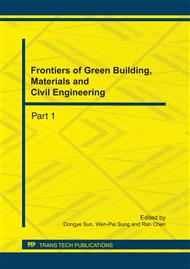p.4293
p.4300
p.4304
p.4309
p.4313
p.4317
p.4321
p.4325
p.4329
Sustainable Campus Design in Malaysia: An Evaluation of Student’s Perception on Four Research University Campuses
Abstract:
The issue of sustainability has been around for a long time. However, it has become a hot issue after the Earth Summit taking place in 1992 in Rio de Janeiro and in 2002 in Johannesburg. Conference in 1992 led to the formulation of Agenda 21, an action plan containing broad principles to help governments and other institutions in carrying out the policies and programs for sustainable development in their respective countries. The aim of this research was to examine the effectiveness of campus physical development planning in Malaysia in creating a sustainable living on campus by assessed the problems that exist. The study was conducted in four public university campuses and limited to only the campus physical planning. Selected campuses are the research universities campus. The case studies were conducted on each campus. The methodology used in this study is qualitative and quantitative techniques. Quantitative technique involves collecting data using questionnaires distributed among 100 respondents for each campus. Meanwhile, the qualitative technique involves collecting comments and opinions from the respondents obtained from questionnaires, behavioral observation and visual research. The results were then compared for each campus for an explanation of the problem. The findings revealed that all campuses had a similar problem. However, there are some differences about the extent or severity of the problems based on campus physical development plan that is different. The result showed that there are minimal problems occurs on the campus that planned more compact compare to a wide and dispersed campus. It also indicates that a compact campus tend to create a sustainable life on campus.
Info:
Periodical:
Pages:
4313-4316
Citation:
Online since:
July 2011
Authors:
Keywords:
Price:
Сopyright:
© 2011 Trans Tech Publications Ltd. All Rights Reserved
Share:
Citation:


